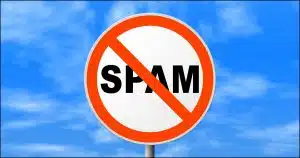Different things in different places.

For reasons I’ll explain in a moment, there is no definitive answer on exactly what happens. However, some general concepts apply when you mark something as spam.
The first thing we need to know is whether you’re marking it as spam in
- An email program running on your machine
or
- An email service online you access via your browser.
The answer for each is quite different.

Marking spam
What happens when you mark an email as spam varies depending on whether you’re using a local email program or an online service. The system learns from your input, potentially filtering similar messages in the future, but the exact mechanism remains intentionally opaque to thwart spammers.
Marking spam in your email program
An email program is software that runs on your computer and downloads messages from your email service to your local hard disk.
Examples of these kinds of email programs include Microsoft Office’s Outlook, Thunderbird, and the Mail program included with Windows (now also called Outlook). There are dozens, if not hundreds, of others.
When you mark something as spam (or junk, as it’s sometimes called) while using an email program, you are typically telling only that program that the email message is unwanted. Particularly if your email account uses the POP3 protocol, the information about what you’ve marked as spam does not make its way back to your email service provider.
The result is that it does not affect what email will be downloaded in the future. It will affect what messages the email program on your PC considers spam.
Help keep it going by becoming a Patron.
Email programs and IMAP
Mobile devices have added a couple of twists on whether marking something as spam in a computer-based email program makes it back to the email service.
Some email services now provide dedicated email programs. On my mobile phone, for example, is an app I use to access Gmail. Technically, that’s an email program (app) running on my computer (the phone). However, since it’s dedicated to handling Google Mail, when I mark something as spam using the program, the information is transmitted back to Google’s servers. Similarly, I have the Outlook mobile app, and when I mark something as junk in my Hotmail account, that information also makes its way back to Microsoft’s servers.
Desktop email programs can use IMAP instead of POP3 to allow you to access your email from multiple different devices and keep everything in sync. IMAP does this by always considering the email on the server as the master copy. Each email program that connects using IMAP maintains a synchronized copy of your mail on your computer. Change, delete, or move mail around in folders on your PC, and those changes are reflected in the master copy.
When you mark an email as Spam, some email programs simply move it into a Spam (or Junk) folder. If you’re using IMAP, when the move is reflected on the server’s master copy, that may be enough to notify the service that this message is spam.
There are no blanket rules, and (aside from dedicated apps like the Gmail and Outlook apps) it’s difficult to make assumptions about how your email program works with your email service when it comes to spam. The best I can suggest is to check the help information available for each.
How email programs use the information
An email program may use the fact that you’ve marked something as spam in several different ways.
- It might add the sender’s email address to a block list. (This is a separate function in some email programs.) Unfortunately, block lists based on email addresses are not effective in the war against spam. Spammers constantly change or fake their email addresses.
- It might add the IP address of the sender (or the sender’s email service) to a block list. Once again, IP-address-based blocking is not effective against spam; spammers send from millions of different IP addresses.
- It might analyze the contents of the message and identify various characteristics of the message it then records as “looking like” spam to you. Incoming email with similar characteristics might be automatically flagged as spam. This is the most common, and currently the most effective, email-program-based spam-filtering technique.
As effective as it can be, the problem with looking for characteristics is that it’s difficult to predict what does or does not constitute spam. You might get an email that is clearly spam to you, mark it as spam, and then later get another nearly identical message that was still not filtered.
These types of learning (or adaptive) filters don’t act immediately. They build up statistical characteristics. The more email you identify as spam, the more those characteristics are updated. It might not be until the second or third (or fourth or tenth) time you mark a particular type of spam that the filter will have enough confidence to kick in and automatically identify similar messages as spam in the future.
“Similar” is, after all, a fuzzy concept.
What email programs do with spam
Great, your email program has successfully identified something as spam. Now what does it do with it?
Most email programs do nothing more than move the email to a Spam folder. That’s it. Period. There’s no notification back to the sender and no notification to the email service. Everything happened on your computer and only on your computer.
This type of spam filtering is nothing more than placing email detected as spam into a different folder as it’s downloaded to your computer. At least it gets it out of your way.
Marking spam online
If you’re using a web browser (like Edge, Chrome, Firefox, or others) to read your email, you’re using an online email service. Your email is stored in the cloud, not on your PC, and you’re simply viewing it via a web-based interface.
Examples of web-based email services include Outlook.com, Gmail, Yahoo Mail, and many, many others. Your own ISP or email service provider may also have a web-based interface for your email besides the services that allow you to access it via your PC.
The important thing here is that you’re using your web browser to interact with your email stored on your email service’s server online.
How email services use the information
When you mark something as spam on an online service, you’re doing essentially the same thing you did above with a PC-based email program: you’re telling the service, “I think email that looks like this is spam.”
The difference is that every other user of that service is also telling the provider what they think is and is not spam.
Exactly how the service provider uses that information is a mystery, and that’s on purpose.
They don’t want spammers to learn the details of the mystery; that would make it easier for spammers to know how to work around it. Also, how service providers use that information is constantly changing in response to the ever-changing nature of spam.
There are several approaches email service providers may or may not use.
- Things that you mark as spam are used to identify and filter spam only for you. This is basically the PC model at the server level. You’re not impacted by the spam decisions of other users.
- Your marking something as spam goes into a single database used for everyone. Only things that everyone thinks look like spam are filtered. No matter how often you mark something as spam, if everyone else on the service treats it as legitimate, you may never see it filtered.
- Hybrid: a combination of what everyone thinks is spam plus what you think is spam is used when filtering email destined for your inbox.
My sense is that most services use the hybrid approach, but as I said, it varies from provider to provider and changes over time.
What email services do with spam
Much like the email program on your PC, when spam is filtered by an email service, it’s moved to a spam folder in your account. You can usually safely ignore and/or periodically check the folder for false positives.
No notice is sent to the sender. The email has, in fact, been delivered; it’s just been delivered to your Spam folder.
Some services take things a step further.
Some services identify spam at a global level — perhaps based on content or source or something else — and block it from being delivered entirely. You never see it in your inbox or your Spam folder. From your perspective, it’s like the email was never sent.
In rare cases, the service may send a bounce message to the sender.
False positives
Regardless of whether you use PC- or web-based email, spam detection is an inexact and ever-changing science. We all see email that we consider spam — perhaps even obviously spam — delivered into our inboxes.
Mark it as spam, and your email program or service learns a little more about what you consider spam. Occasionally, however, legitimate mail gets marked and filtered as spam. We call this a false positive.
You can correct false positives. For anything filtered and placed into a Spam folder, you can say “This is NOT spam.” This is perhaps even more important than identifying spam.
Once again, this teaches the program or service that email like this should not be considered spam.
That’s an important step to take. Every so often, spend a few minutes in your Spam folder looking for things that were filtered and should not have been. Mark those as “not spam” to reduce the chance of similar mail in the future also being filtered.
Do this
Mark spam as spam. If you find legitimate email in your spam folder, mark it as not spam. That’s the most effective thing you can do to deal with spam.
Also, if lots of email goes directly to your spam folder, and it is indeed all spam, that’s the system working as it should. When working perfectly, only spam lands in your spam folder. Everything else shows up in your inbox, and you only have to pay attention to that.
Subscribe to Confident Computing! Less frustration and more confidence, solutions, answers, and tips in your inbox every week.







This is ridiculous.. If the spam addresses are noted ( I know they sometimes change but most don’t) then the manufacturers of the phones should be able to filter the offending articles we have bothered to point out for them as part of the phones programming.. We don’t have to deal with the whole internet’s tricks just our own devices..
I hope I’m not now going to have to deal with more spam when this data is potentially stolen/sold, by the provision of my details.. To be clear,not accusing you of such.. bigger fish than you have been caught in the net..
Spammers constantly change their sender’s address. That’s why blocking addresses or IP numbers isn’t effective.
Spam is annoying but mine is nearly always delivered to my junk folder. It doesn’t take too long to skim down the (long) list and delete them all. What I want to know is why do people send spam? Can it really be worth their while?
If a spammer sends out 1,000,000 emails and only 10 get the product, the spammer made money. They probably have a higher number of victims than that. They send out hundreds of millions of spam mails daily.
Yes. It costs them very little, and when even a tiny percentage of people fall for it, they profit.